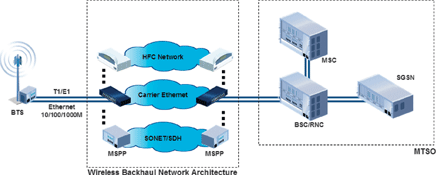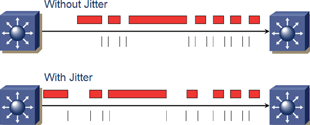
When extending the efficiencies of their Ethernet network to their time-division multiplexing (TDM)-based cellular backhaul infrastructure, service providers have to determine the parameters they need to test to ensure that they are delivering a circuit that is comparable in performance quality to a legacy TDM circuit.
They know they must provide T1/E1 circuits to support voice applications and Ethernet circuits for data services, but are the circuit parameters the same as in a carrier Ethernet environment?
This article covers the anatomy of a cellular backhaul network (also known as mobile backhaul), and the specific Ethernet and TDM tests required to certify its quality.
Anatomy of a cellular backhaul network
Not all backhaul service provider (BSP) networks are created equal. Depending on the location of the base transceiver station (BTS) and the transmission services required (legacy TDM and/or Ethernet), BSPs must adapt their network to extract the most efficiency and performance out of the equipment they have available.
As native Ethernet to the base-station is still in its infancy, legacy TDM remains the preferred hand-off interface and the easiest way for a BSP to deliver services. A multiservice provisioning platform (MSPP) is installed at the base-station and multiple T1/E1 circuits are delivered. This architecture is also future-proof as MSPPs can be upgraded with Ethernet interfaces to also deliver carrier Ethernet services (CES).
There are two other methods of delivering T1/E1 and Ethernet to the base-station. First, as competitive local exchange carriers (CLEC) continue the build-out of carrier Ethernet backbones, they are also looking at implementing this architecture to deliver new services. With the work done by the Metro Ethernet Forum (MEF) and other standards bodies, it is now possible to deliver cellular backhaul services over a carrier-grade Ethernet backbone using circuit emulation services (CES).
Secondly, some BSPs are also cable TV (CATV) operators. As CATV operators cover large geographical regions and not just the metropolitan area, they can provide cellular backhaul services to up to 80% of all base-stations in the US, making them a major force in the cellular backhaul market. Furthermore, the DOCSIS technology used by the majority of CATV operators enables them to deliver cellular backhaul services for both legacy (T1/E1 SONET/SDH) and Ethernet circuits.
Figure 1 demonstrates the different network architectures that can be used to deliver cellular backhaul services. To the network operators, the backhaul network is transparent but requires strict adherence to performance parameters.

Quality of service requirements for cellular backhaul to a BTS
Depending on the network architecture used to deliver services and the type of services delivered (T1/E1 or Ethernet), there are multiple parameters that need to be tested to ensure that the cellular backhaul network will work according to specifications. As T1/E1 circuits are synchronous and Ethernet circuits are asynchronous, this article will cover the testing requirements of each environment separately.
T1/E1 test requirements
T1 and E1 are the base of the plesiochronous digital hierarchy worldwide. As these circuits are very stable, base-stations use them as a synchronisation source. Some of the tests used to install and maintain base-stations are:
* BERT (availability).
* Round-trip delay (to provide differential transmission delay).
* Service disruption measurement.
* Network monitoring.
Bit-error-rate testing (BERT) is the most common test used to qualify circuits. It is not rare to see a BER of 10-9 to 10-6 required as part of service-level agreements (SLA). Other parameters that complement BER are availability (better than or equal to 99,99%) and error-free seconds (better than or equal to 99,999%). These two measurements need to be compiled over a one-month period.
Round-trip delay is measured as the time between the transmission of a bit and its reception. In the case of cellular backhaul, this measurement is the round-trip time from the base-station to the base station controller (BSC) and back to the original base-station. This value varies from one provider to another, but a generally accepted value is typically less than 16 milliseconds.
Another parameter that needs to be tested is service disruption. As T1/E1 services are usually delivered over a SONET/SDH architecture, and because of the importance of connectivity for a base-station, a service disruption measurement should be performed.
From a maintenance perspective, having the capability to monitor a circuit is very important. Bringing a link down for a test is not always an option; therefore operators require the ability to do in-service testing. By having the capability to see each side of a T1/E1 transmission, technicians can monitor both sides of the transmission for bit errors, facility data link status, timing slips etc, while the circuit is still in service.
Ethernet test requirements
In an Ethernet environment, frames get dropped when an error occurs; therefore frame loss measurements become more critical than BER testing. Here are the tests required from an installation perspective:
* RFC 2544 tests for throughput and latency.
* Frame loss measurement (and detection of out-of-sequence frames).
* Packet jitter.
* Service disruption measurement.
Throughput and latency measurements are essential for rapidly assessing the ability of an Ethernet circuit to deliver traffic. These measurements provide circuit capacity and round-trip delay measurements that are crucial for ensuring voice quality.
When a transmission error occurs in Ethernet, frames get discarded and the upper transmission layers handle the retransmission. Because of this behaviour, quality in an Ethernet network is defined as frame loss/error rate. A generally accepted value for a frame error/loss rate is typically between 10-6 and 10-5, which translates to a frame loss every 100 000 to 1 000 000 frames.
Packet jitter (also known as packet delay variation) refers to the variability in arrival time between consecutive packets. Figure 2 provides a graphical view of this phenomenon.

The impact of packet jitter on a cellular backhaul network can be disastrous; packet jitter on an encapsulated T1/E1 circuit diminishes the quality of the service. As defined in MEF 3, to successfully transport CES, packet jitter should be less than 10 milliseconds. However, from an operator perspective, this value needs to be more in the range of 1 millisecond to ensure the base-stations maintain proper network synchronisation. Fortunately, carrier grade Ethernet networks are easily capable of delivering this level of packet jitter quality.
Finally, having the capability to measure service disruption at the Ethernet layer will provide operators with the confidence that the Ethernet network has the same resiliency as found in TDM networks.
From a maintenance perspective, it is important to monitor the traffic in-service. As monitoring ports (DSX type) do not usually exist in an Ethernet network, service providers tend to use mirror ports to monitor traffic.
Conclusion
The continued growth of mobile voice traffic, coupled with an ever-increasing rise in 3G multimedia traffic, is forcing service providers to examine alternate backhaul solutions to drive down operation expenses associated with traditional T1/E1 leased lines.
With Ethernet emerging as the solution of choice, operators must also consider testing solutions that address both the new Ethernet environment as well as the legacy T1/E1 environment to ensure that services meet the stringent quality standards customers have come to expect.
With the proper architecture and test equipment, cellular backhaul service providers can conclusively demonstrate that their network is capable of delivering services equivalent to any other service provider.
| Tel: | +27 12 349 1341 |
| Email: | [email protected], [email protected] |
| www: | www.lambdatest.co.za |
| Articles: | More information and articles about Lambda Test |

© Technews Publishing (Pty) Ltd | All Rights Reserved